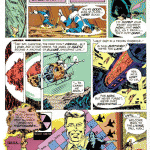
Comic books represent not only the typical constraints of language (idiolect, double meanings, idioms, et al.) but also space limitations. As we all know, comics provide information not only through words but they are also linked to an image and the translator should confine translation to the space they have. Keep in mind that in most cases the original author does not do their work thinking about how it will be translated but about ensuring that the bubbles have the exact right size to fit the text. The translator also doesn’t have some of the same workarounds that can be used in other texts, such as explanatory notes, footnotes, etc.
Therefore, in order to provide a more or less acceptable translation that is as close as possible to the original, we have to remove any merely accessory content which is the same that happens with subtitling, for example, which also has strict space limits.
Unfortunately, this type of translation, there will be occasions when important text will be eliminated because there is no possible way in the target language to translate the original idea in the limited space available, which is quite frustrating for translators who knows that the reader will not receive the full information; however, this is something that has to be understood as a part of the work.
An equally important problem is the varying onomatopoeia in comics, both which are not inside the bubbles but also those in the animation, since, in general, they tend to be highly characteristic of the use of country of origin (for example, they are widely used and, indeed, play a key role in U.S. comics) but for the reader from another country they may have no meaning. The solution in these cases is usually a change to the design but in addition to being quite expensive, it brings into question the extent to which the work of the cartoonist, who is an artist whose work should be respected, should be amended. In most cases the original is usually left or other solutions, which are normally unsuccessful, are used, such as attempting to put the translation in the blank space left between bullets or add a small sign next to the onomatopoeia.
You could tell a lot about the complex nature of such texts but my intention was to gather briefly on the most problematic aspects of this type of translation. It is a truism to say that professionals rely on experts in this field who know perfectly the source language, its idioms, expressions, etc, It is vital to be able to translate the original not only as faithful as possible but also to stick to the original space so that the minimal amount of information is lost.
(Spanish version: https://www.trustedtranslations.com/la-traduccion-de-comics-2010-09-17.html)





